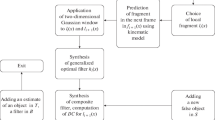Abstract
In this paper we consider some possibilities for applying object oriented approach to developing Target Tracking (TT) programs. We examine one of the main parts of TT algorithms — track evaluation — and propose a structure of classes that may simplify and alleviate creating and testing TT programs. These classes implement tracks, and consist of data and methods describing track kinematics - vectors, matrices and filtering algorithms. The track hierarchy contains classes for Linear Kalman Filter, Extended Kalman Filter and Probabilistic Data Association Filter. An example shows how Interacting Multiple Model (IMM) filter can be implemented using objects of these classes.
The research reported in this paper is supported by Center of Excellence BIS21 grant ICA1-2000-70016.
Access this chapter
Tax calculation will be finalised at checkout
Purchases are for personal use only
Preview
Unable to display preview. Download preview PDF.
Similar content being viewed by others
References
Bar-Shalom Y., Blair W.: Multitarget-Multisensor Tracking: Applications and Advances, vol 3. Artech House (2000)
Bar-Shalom Y., Xiao-Rong Li: Estimation and Tracking: Principles, Techniques and Software. Artech House. (1993).
Bar-Shalom Y., iao-Rong Li: Multitraget-Multisensor Tracking: Principles and Techniques. YBS (1995)
Blackman S.S.: Multiple-Target Tracking with Radar Applications. Artech House (1986)
Georgiev Vl., Georgieva J. et all: Manual for using of computers and programming in C++. Sofia (2000) (in Bulgarian)
Karaivanova A., Djerassi E.: Track Formation Using MHT Approach. Proc. of the International Conference on Mathematical Modeling and Scientific Computations. DATECS Publishing. Sofia (1993) 31–33
Simov G.: Programming in C++. SIM. Sofia (1993) (in Bulgarian)
Author information
Authors and Affiliations
Editor information
Editors and Affiliations
Rights and permissions
Copyright information
© 2003 Springer-Verlag Berlin Heidelberg
About this paper
Cite this paper
Djerassi, E., Konstantinova, P. (2003). Tracking Algorithms Represented as Classes. In: Dimov, I., Lirkov, I., Margenov, S., Zlatev, Z. (eds) Numerical Methods and Applications. NMA 2002. Lecture Notes in Computer Science, vol 2542. Springer, Berlin, Heidelberg. https://doi.org/10.1007/3-540-36487-0_31
Download citation
DOI: https://doi.org/10.1007/3-540-36487-0_31
Published:
Publisher Name: Springer, Berlin, Heidelberg
Print ISBN: 978-3-540-00608-4
Online ISBN: 978-3-540-36487-0
eBook Packages: Springer Book Archive




